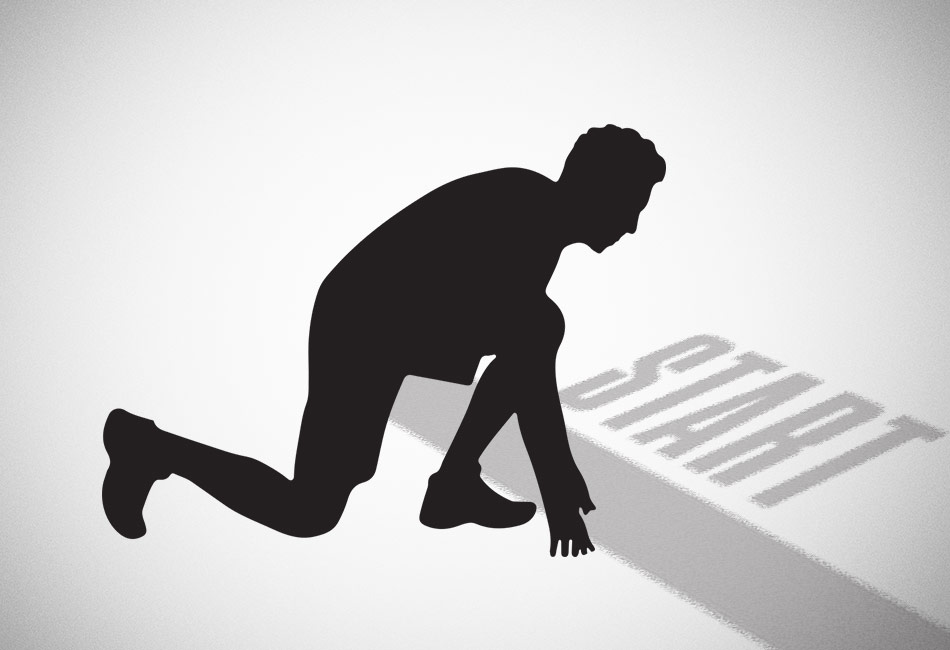If you stopped exercising and are thinking of getting back into it you’re familiar with the strong feeling of guilt that comes as you consider how to best go about it. With it also comes an uneasy mix of dread (because you know just how difficult it will be to get fit again), uncertainty and fear that you will now fail to rekindle your fitness quest. No wonder then that the first response that comes to mind is to give it up already and try and find something new.
All of this is natural. Deconstructing why you feel the way you do will help you work out for yourself how to handle it all better and make getting back into fitness easier than you could ever hope for. People choose to exercise for a variety of reasons. Some of these are extrinsic (to look slimmer, stronger and sexier) and some are intrinsic (to feel better, relieve stress and have greater physical control). Traditionally, extrinsic motivators are short-lived and can potentially work against us (for example, if we feel that the way we change physically through exercise is not fast enough we can become demotivated and give up) while intrinsic ones keep us coming back to exercise again and again. This however, is not the whole picture.
The reasons why we exercise are multi-layered and separated into three distinct areas that are themselves closely linked:
Physical – Through exercise we achieve a physical transformation. We become, faster or stronger, have greater endurance and increased physical power.
Cognitive – We exercise because we know it is good for us. Study after study tells us that regular exercise is good for the body, slows down the ageing process and helps the brain function better, staving off mental degenerative diseases like Alzheimer’s and ensuring a better quality of life as we age.
Affective – Exercise is our go-to drug for mood enhancement and stress-relief. We use it to make ourselves feel good when we are low and frequently get addicted to the high it generates.
Expectations Define What You Get
The body affects the brain which runs the mind. There is an inevitable feedback loop from each one to the other two so what we experience, think and feel become the backdrop against which our motivation is shaped. Motivation is also a complex mental construct with neurobiological implication but we won’t go into it here beyond reducing it into a simple sentence: you only do what you really want.
Because no one can make you do something you don’t want to do you can only stick to regular exercise if your reasons for doing it are really strong and there is some alignment between what your brain is telling you, your mind is feeling and your body reports.
When you first started to exercise everything was new. Whatever ideas, misconceptions and expectations you brought into it were probably blown away pretty quickly once you really started to get fitter but that was fine because you were on a roll. When we see progress the reward mechanism in the brain is activated and we feel good about ourselves. This makes the effort involved and the physical discomfort we experience seem a price worth paying, so we don’t care too much about it.
Starting Again is Harder
At some point life will get in the way. Even the most committed of us will then take a break and then, at some other point, we will consider getting back into exercising regularly and getting fitter again. And that’s when we shall hit this wall.
First off is the guilt. We feel guilty for stopping and now are feeling guilty for coming back into training again. Part of us feels that coming back is worse because now we own up to having stopped. We feel guilty because we feel we also admit weakness. Life got too much for us to handle. Then there is the resistance we feel because we know that it is going to be physically tough getting back into training.
When we started it wasn’t so bad. The pull of the new made everything seem like an adventure and that made the physical effort involved something we could handle. But this now is a ‘comeback’. All we remember of the past are the achievements we had made, which now seem very far away, and the physical difficulty of exercise itself.
Both these feelings are also natural and a trick played by the way the brain is designed to operate. When our brain looks back into the past at achievements it focuses on what has been achieved. Because the achievement is rooted in direct experience we naturally feel it in a really vivid way and overvalue what it was. In the same way when the brain focuses on something lying ahead it sees only what is difficult because it has no way of gauging anything in the future beyond the effort required to get there.
In case you’re wondering these are neural survival mechanisms that have been created over hundreds of thousands of years to keep us moving forward. In this particular case however they conspire to keep us back by making the past seem untenably great and the future incredibly difficult. As a result we get demoralized. A 2016 study found that muscles that have been de-trained because of a break have muscle memory but there is a time lag before that kicks in. That time lag is sufficient for those who are trying to get back into shape to feel dispirited as they don’t see the results they expect.
The Smart Way To Regaining Your Fitness
The ‘secret’ formula to getting back into fitness after a lay-off takes all of this into account:
- Forget about the guilt. We all, at some point, fall off the wagon and stop training. That’s now behind you. Embrace it and focus on what you’re doing now.
- Ease back into training. Don’t go flat out thinking that what you had achieved in the past will somehow magically reappear and carry you through.
- Set small, feasible targets that take into account your current level of fitness and work to achieve them.
- Get support. Going it alone is the worst possible way to tackle this. Get friends who are also training or beginning their training, just like you are. Become each other’s cheerleaders and support network.
- Keep in touch. Stay current with fitness research. Read about exercises. Watch fitness videos. Keep it all flowing.
- Stay Zen. You know how good you used to be and you can see the gap between the “you” back when you were fit and the “you” that is training now. The good news is that since you’ve done it before you can do it again. Cut yourself some slack and stop stressing out about it.
- Enjoy the journey. Life is full of unexpected twists and turns, ups and downs. What’s really key here is that you’re alive and training and enjoying every moment of it.
- Share the journey. Whether it’s talking to people in The Hive, sharing what you’re doing with friends, keeping a blog or a diary, it’s important to be open about it and hold yourself accountable. Every fitness journey shared is unique. Each one is inspirational. Be the hero not just of your own narrative to a better version of you but also those of others around you.
Above all remember that it’s small, consistent steps that get you where you need to be and there are no shortcuts.










